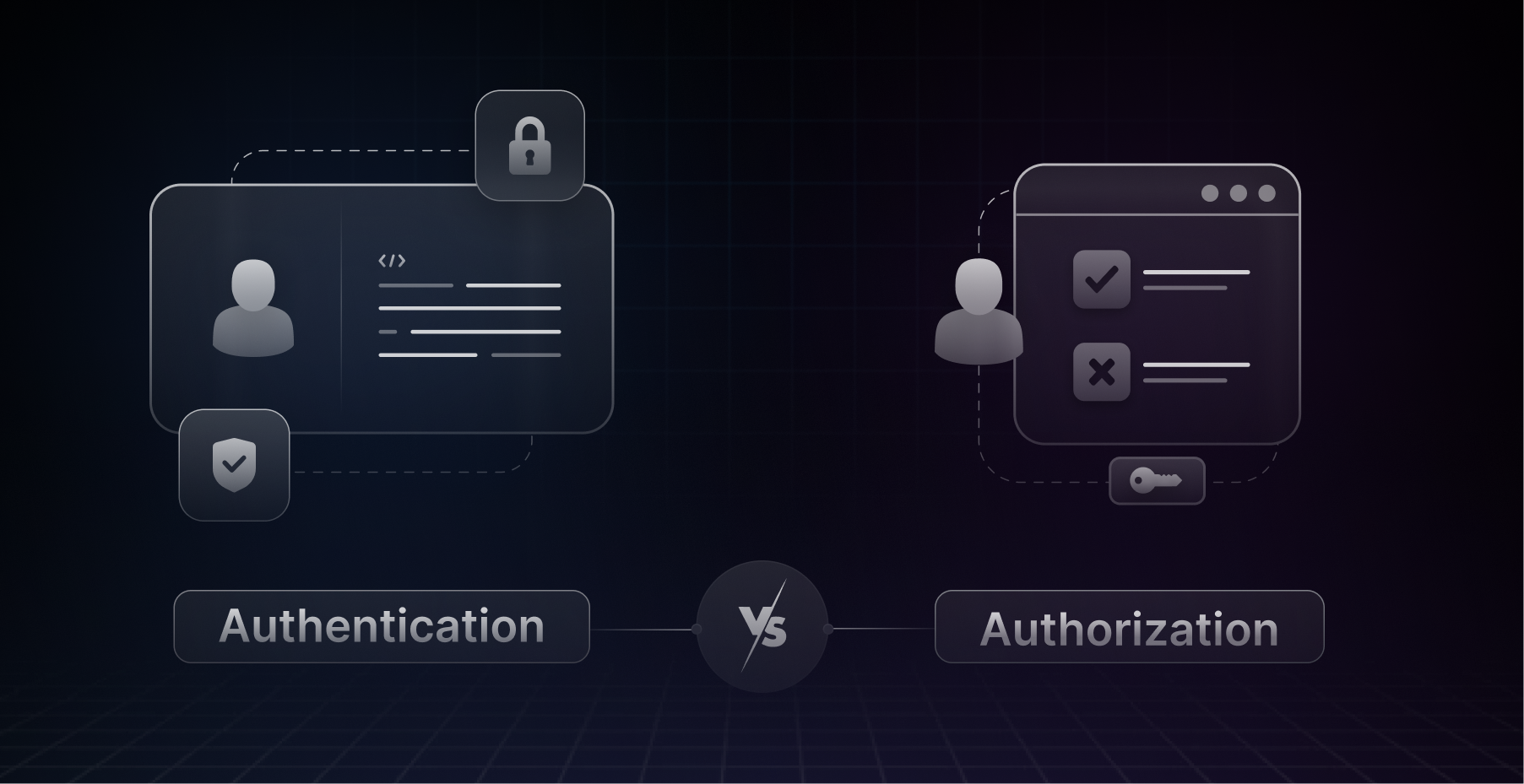Table of Contents
- Introduction
- What is Authentication & Why is it Important?
- Common Methods of Authentication
- What is Authorization & Why is it Important?
- Common Methods of Authorization
- Key Differences Between Authentication and Authorization
- Authentication vs Authorization: Factors & Permissions
- How to Choose the Right Method for Your System
- Conclusion
Introduction
Although they are often conflated with each other, Authentication and Authorization represent two fundamentally different aspects of security that work together in order to protect sensitive information. In this blog, we will go over some of the key differences between the two.
What is Authentication & Why is it Important?
Authentication is the process of verifying that you are who you claim to be. Think of it as the bouncer at an exclusive club, checking your ID before letting you in. In the digital world, this process ensures that only legitimate users can access their accounts and sensitive information. Why is authentication so crucial? Well, imagine if anyone could log into your email or bank account without proving their identity. Scary, right? Strong authentication mechanisms are the first line of defence against unauthorized access, protecting both individuals and organizations from potential security breaches.
Common methods of authentication
Authentication asks the user to validate the identity by providing one of the following:
- Something You Know:
- Something You Have:
- Something You Are:
Over the years, authentication methods have evolved to meet growing security challenges. Let’s take a look at some common approaches:
Traditional Methods
- Passwords: The most familiar form of authentication. While simple, they’re vulnerable to various attacks if not properly managed.
- PINs (Personal Identification Numbers): Similar to passwords but usually numeric and shorter. Often used in combination with other methods.
Modern Methods
- Biometrics: Uses unique physical characteristics like fingerprints or facial features. Highly secure but can be expensive to implement.
- Multi-Factor Authentication (MFA): Combines two or more authentication methods for enhanced security. For example, a password plus a fingerprint scan.
- Single Sign-On (SSO): Allows users to access multiple applications with one set of credentials. Convenient but requires careful implementation to avoid security risks.
Emerging Trends
- Passwordless Authentication: Eliminates the need for passwords, often using biometrics or security keys instead. Gaining popularity due to improved user experience and security.
Each method has its pros and cons, and the choice often depends on the specific use case and security requirements.
What is Authorization & Why is it Important?
While authentication lays the groundwork by confirming identity, authorization takes it a step further by determining what actions or resources an authenticated user can access. In simpler terms, authorization addresses the question, “What are you allowed to do?” and defines the scope of a user’s privileges within the system. This level of granularity is essential for protecting sensitive information and controlling data exposure to prevent unauthorized activities.
Authorization might sound a bit abstract, so let’s look at some everyday situations where it’s super important:
- At the hospital: It ensures doctors can see your relevant medical info, but keeps your sensitive data private from other staff.
- In your banking app: It controls who can view your account, make transfers, or approve loans.
- On shopping websites: It decides what sellers can change in their stores and what you can buy as a customer.
- At your workplace: It manages who can access different company files and systems.
Common Methods of Authorization
Authorization methods determine what actions authenticated users can perform within a system. The choice of method often depends on factors like organization size, access requirement complexity, and data sensitivity. Let’s explore some common authorization approaches.
-
Role-Based Access Control (RBAC): It is widely adopted for its simplicity and scalability. RBAC assigns permissions based on predefined roles that typically correspond to job functions. For instance, in a content management system, roles like “Editor,” “Author,” and “Viewer” might exist, each with different access levels. This approach simplifies administration, especially in large organizations, as managers can assign roles rather than individual permissions. You can learn more about RBAC in our guide
-
Attribute-Based Access Control (ABAC): It offers a more flexible approach by making access decisions based on attributes of the user, resource, and environment. This granularity allows for highly specific access policies adaptable to complex scenarios. For example, a healthcare system might grant a doctor access to patient records based on their role, department, time of day, and location. While ABAC provides unparalleled flexibility, it comes with increased complexity in setup and maintenance.
-
Policy-Based Access Control (PBAC): It uses centrally managed policies to determine access rights, often incorporating elements of both RBAC and ABAC. This method allows organizations to create comprehensive, context-aware access rules that can be easily updated across the entire system. PBAC is particularly useful for organizations with complex, evolving access requirements or those operating in highly regulated industries. However, it requires careful policy design to avoid conflicts and ensure optimal performance.
Organizations may choose to implement one of these methods or combine them based on their specific needs. Smaller organizations with straightforward access requirements might find RBAC sufficient, while larger enterprises or those dealing with highly sensitive data might lean towards the granularity of ABAC or the comprehensive control of PBAC. Regardless of the chosen method, the goal remains to ensure that the right users have access to the right resources under the right conditions, maintaining security without impeding productivity.
Key Differences Between Authentication and Authorization
The importance of both authentication and authorization cannot be overstated. While authentication ensures that only legitimate users gain access to a system, authorization guarantees that these users are confined to their respective permissions and cannot perform unauthorized actions.
Imagine a scenario where a user has successfully authenticated but lacks proper authorization controls. This user, perhaps with malicious intent or due to a careless mistake, could inadvertently cause significant damage to critical data or systems, putting the entire organization at risk.
On the other hand, effective authorization without proper authentication is equally problematic. An unauthorized user could bypass authentication measures and gain access to sensitive information, leading to data breaches, financial loss, and severe reputational damage.
| Aspect | Authentication | Authorization |
|---|---|---|
| Definition | Process of verifying user identity | Process of verifying user access level |
| Purpose | Verifies that users are who they claim to be | Ensures users can only access assets they’re allowed to |
| Main Goal | Keeps out suspicious or malicious users | Restricts authenticated users to appropriate access levels |
| Process | Compares user-provided credentials to stored records | Checks user rights against access control lists |
| Common Methods | Username/password, security questions, OTP, biometrics | Role-Based Access Control (RBAC), Attribute-Based Access Control (ABAC) |
| Credential Basis | What the user knows, has, or is | User’s role or attributes in the system |
| Timing | Occurs first in the security process | Takes place after successful authentication |
| User Interaction | User actively provides credentials | Typically happens in the background |
| Outcome | Confirms user identity | Determines user permissions |
| Error Messages | “Invalid username/password”, “Account locked” | “Access denied”, “Insufficient permissions” |
| Security Impact | Protects against unauthorized access attempts | Prevents authenticated users from abusing privileges |
| Modification Frequency | Changed when credentials are compromised | Updated with changing user roles or system policies |
| Scalability Challenges | Managing credentials for large user bases | Complex permission structures in large organizations |
Authentication vs Authorization: Factors & Permissions
Both authentication and authorization are influenced by various factors:
Authentication Factors
- Something you know (password, PIN)
- Something you have (security token, smartphone)
- Something you are (biometrics)
Authorization Factors
- User role
- Department
- Time of day
- Location
- Device type
Permissions, which are central to authorization, define what actions a user can perform on a given resource. These might include:
- Read
- Write
- Execute
- Delete
- Admin
The specific permissions available depend on the system and the resources being protected.
How to Choose the Right Method for Your System
Selecting the appropriate authentication and authorization methods for your system is crucial. Here are some factors to consider:
- Security Requirements: How sensitive is your data? High-security environments might require multi-factor authentication and granular authorization controls.
- User Base: Consider the technical proficiency of your users. Complex authentication methods might frustrate less tech-savvy users.
- Scalability: Will your system need to accommodate a growing number of users or roles?
- Compliance: Are there industry regulations or standards you need to meet?
- Integration: How well will the chosen methods integrate with your existing systems?
Here are some examples of different scenarios that might influence your choices:
- A small business website might use simple password authentication and role-based authorization.
- A financial institution might implement multi-factor authentication and attribute-based access control.
- A large enterprise might opt for single sign-on with policy-based access control for flexibility across multiple systems.
Real-World Case Studies
- E-commerce Platform: Amazon
- Authentication: Multi-factor authentication (password + OTP)
- Authorization: Role-based access control for sellers, buyers, and admins
- Rationale: High security needs due to financial transactions, large user base with varying technical skills
- Social Media: LinkedIn
- Authentication: Password + optional two-factor authentication
- Authorization: Role-based access control for different account types (personal, business, recruiter)
- Rationale: Balance between security and user convenience, need to manage different levels of access for various account types
Tips for Implementation
- Use Strong Password Policies: Enforce complex passwords and regular changes.
- Implement Multi-Factor Authentication: This significantly enhances security for sensitive systems.
- Regularly Review and Update Permissions: Ensure users only have the access they need.
- Monitor and Log Access Attempts: This helps detect and respond to potential security breaches.
- Educate Users: Train your team on the importance of security and how to use authentication systems properly.
Conclusion
Authentication and authorization are the twin pillars that safeguard our sensitive information. Authentication sets the foundation by verifying identity, while authorization fortifies access controls, determining user privileges. The synergy of these two elements creates a robust security framework that protects organizations and individuals alike. By adhering to best practices and staying vigilant, we can confidently navigate the digital landscape with security and peace of mind.
Remember, it’s not just about “Who are you?” or “What are you allowed to do?” but rather the powerful combination of both that establishes a defense against malicious attackers.

